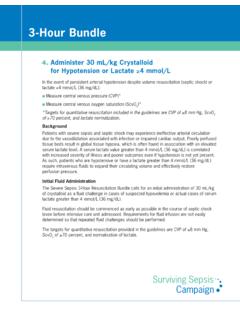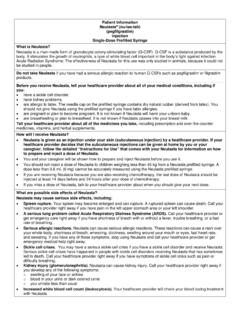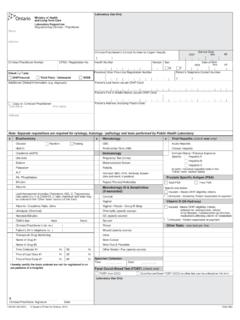Transcription of Intravenous Fluids: In the ER and on the floor
1 Intravenous Fluids: in the er and on the floorIntravenous Fluids: In Intravenous Fluids: in the er and on the floorthe ER and on the floorMEVallettaMEValletta, MD, MDAugust 4, 2005 August 4, 2005 Resident Core Conference Lecture SeriesResident Core Conference Lecture SeriesObjectives Understand appropriate fluid resuscitation Understand appropriate fluid choice-IV versus oral, and type of IVFs Learn factors that will likely impact choiceType of IVFsIV fluid (meq/L) NaClKGluBicarbD5W00050g/L0D5W NS3434050g/L0D5W NS7777050g/L0LR130 109 4028D5 LR130 109 450g/L28D5 NS154 154 050g/L0 Electrolyte free water (EFW) in Parenteral FluidsIV fluidNaOsmTonicity% EFW(mOsm/L)D5W0252 0100D5W NS3432178D5W NS77406 15050LR130 27316D5 LR130 52516D5 NS154 560 3080 Osmolarity vs Tonicity Osmolarity is the number of osmoles of solute per liter of solution Tonicity is the total concentration of solutes which exert an osmotic force across a membrane in vivo Dextrose is not considered to have an osmotic effect because it is rapidly metabolized in blood For substances that cannot cross cell membranes, tonicity is practically identical to osmolarityWhat we all learned:Holliday & Segar Method Pediatrics 1957.
2 19: 823-32 Maintenance water needs related to energy expenditure requirement, related to weight (<10kg, 10-20kg and >20kg) Na of 3 mEq /K 2 mEq/ Cl 2 mEq/ 100 kcal / 24 hours Equal to about 30 mEq of Na in 1000 ml which is roughly NS Na and K recommendations arbitrarily based on the composition of electrolytes in breast and cow milk fluid calculations based on keeping urine osmolality of 400 mOsm/kg/H2O believed to be ideal Electrolytes based on infused at 20 meq/kNa-meq/kNa-3 meq/100 kcalFluid mlWt-kgMaintenance IV fluid in Children Example: 10 kg infant fluid : 100 ml/kg/d = 1000 Na 3 mEq /kg/d = 30 mEq IV fluid D5 NS= 34 mEq of Na in 1 liter of D5 WIVF Calculations K approximately 2 meq/k/d 10 kg child=20 meq/k/d 20meq/1000= 20meq/L of KCl So per Holliday/Segar method: D51/4 NS with 20meq/L KCL at 40 ml/hourMaintenance IV fluid in Children 40 kg child fluid : ~ 2000 ml Na: 3 mEq/ kg = 120 120 mEq of Na in 2 liters=60meq/L D5 NS= 75 mEq of Na in 1 liter of D5 WIVF Calculations K again 2 meq/k/d=80meq/k/d 80meq/2L= 40 meq/k/1L Start though with max of 20meq/L of KCL (and patient must be urinating) unless patient is hypokalemic because of risks associated with hyperkalemia Remember although declining K requirement with weight, K frequently depletes with Na in sick kids Additionally, acid base status affects intra-extracellularshifts of K So for this child.
3 D5 NS with 20meqKCL/L at 80ml/hourIVF Calculations Diarrheal Dehydation Na deficit likely to be 8-15 meq/k depending on whether iso or hyponatremic K deficit can likewise be 8-15 meq/k May see similar requirements in infants with pyloric stenosis Never infuse K at >1 mEq/k/hour, if exceeds mEq/k/hour need cardiorespiratory monitoringDehydrated Patients Are they dehydrated? Gold standard is measurement of acute weight loss! Practically we rely on clinical assessmentSuggested Approach to Clinical Assessment PPV for any of the clinical criteria were low ( to ) Whereas NPVs were generally high ( to ) Both because of the low prevalence of dehydration However, four of the ten clinical parameters were found to be significantly associated with a fluid deficit of 5% or more dehydrationValidity and Reliability of Clinical Signs in the Diagnosis of Dehydration in Children Gorelick MH et al Pediatrics 1997.
4 Assessment of Dehydration 10 Clinical Parameters Dry mucous membranes Sunken eyes Abnormal radial pulse Tachycardia (HR>150) Decreased UOP Decreased skin elasticity Cap refill >2 sec General Appearance Absent Tears Abnormal respirationsSuggested Approach to Clinical Assessment Evaluate four of the ten: Abnormal general appearance-lethargic, drowsy, limp, cold, etc. Capillary Refill >2 sec Dry mucous membranes Absent tears Presence of any two indicates deficit of 5% or more Presence of three or more indicates deficit of 10% or greater If less than 2, consider ORT therapy!Resuscitation Always isotonic fluids!!!-Normal Saline Bolus 20ml/kg (unless neonate than only 10ml/kg) REASSESS! REASSESS! REASSESS! Studies have demonstrated reduced ADH levels with adequate initial fluid resuscitationPost-Resuscitation Need to assess BMP Is patient hypo, iso or hypernatremic?
5 Is the patient acidotic? What is underlying acute illness? Are there any complicating aspects or underlying chronic medical conditions?Pitfall with the Holliday Segar method Based upon fluid and electrolyte requirements of HEALTHY children! Accordingly, does not take into account increased ADH levels in hospitalized childrenOddball Out:The HypernatremicDehydrated Patient These are the patients who need free water! They may not appear as clinically dehydrated as they are because they are maintaining intravascular volume Skin may be doughy in texture If unsure how acutely the patient became hypertonic, do not correct more quickly than or 10-12 meq over 24 hour periodThe HypernatremicDehydrated Patient In order to decrease Na by 1 mEq/L may estimate 4ml/kg Free Water Deficit= 4ml/kg x preillnessweight x (Current Na goal Na) Replace FWD with solute fluid deficit and maintenance over 24 hours and REASSESSH ypernatremic Dehydrated Patient.
6 Example Calculation Determine % dehydrated based upon clinical grounds 10 kg toddler estimated at 10% dehydrated Preillness weight=Current weight/(1-%dehydrated) 10 or 10 = 11kg Weight down 1kg (1 kg=1L fluids) Deficit of fluids equals 1L but how much of that is free water deficit and what if he got a bolus of NS?Hypernatremic Dehydrated Patient: Example Calculation Patient received 20ml/kg bolus or 200ml NS Serum Na 155 FWD=4ml x 10kg x (155-145)=400ml Total fluid Deficit=1000 of which 400ml is FWD so solute fluid deficit is 600ml 600 solute fluid deficit minus 200ml NS bolus so now remaining deficit is 400 solute fluidHypernatremic Dehydrated Patient: Example Calculation May calculate Na and K solute deficit as follows: (Extracellular compartment) x (solute deficit) x 145 (normal Na)=23mEq (Intracellular compartment) (solute deficit) x 150 (normal intracellular K)=36mEqSo-o-o-o 24 hour maintenance 10kg x 100ml/kg= 1000ml Plus FWD ( of 400)=200ml Plus solute deficit of 400ml Total fluids for 24 hours 1600 or 67ml/hourSo-o-o-o Na 23 meq deficit plus 33 meq(maintenance of 3 x 11kg)=56meq/1600ml or 35meq/L K 36 meq deficit plus 22 meq (2 x 11kg)=58meq/1600ml or 36meq/L Appropriate initial fluids would be D5 NS with 20-30meq KCL/L at 65 ml/hour Recheck Na/k Q4hours to follow initiallyThe New Debate:The role of isotonic maintenance fluids Moritz and Ayus: Prevention of Hospital Acquired Hyponatremia: A case for using Isotonic Saline Pediatrics 2003; 111; 227-230.
7 The Risk of Hypotonic fluid infusion with elevated ADH levels Acute hyponatremia iatrogenicallycaused Hyponatremic encephalopathy with resultant neurological compromise or even deathEtiology in the inpatient setting Sick kids have impaired ability to excrete free water Sick kids have nonosmotic stimulus for ADH production Peculairly at risk because sick kids have big brains and small skulls: Adult brain size by age 6. Adult skull size though not until age 16!Excess ADH-Maybe inappropriate orappropriateDecreased ECV Hypovolemia-Potent stimulus for ADH GI losses Renal Losses: Salt wasting nephropathy (cisplatinand ifosfamide nehphrotoxicity) diuretics, cerebral salt wasting, hypoaldosteronism Edema forming states: CHF, cirrhosis and nephrosis, hypoalbuminemia HypotensionExcess ADH-Inappropriate CNS Disturbances: Meningitis, encephalitis, brain tumors, CHI Pulmonary Dz RSV, asthma in this setting, however the etiology is often related to cardiac compression by lungs Perceived as lower intravascular volume Cancer: Lymphoma and LeukemiaExcess ADH-Inappropriate Meds.
8 Cytoxan (cyclophosphamide)-Increased renal effects of ADH vs direct tubular effect (ADH levels do not rise) Vincristine-Significantly increased levels of ADH Morphine Anesthetics Nausea, emesis, pain stress Post-Op stateIncidence of Hyponatremia and hyponatremic seizures in severe RSV bronchiolitis Median age 6 weeks Hyponatremia at time of admission to ICU occurred in 33% (30/91) of cases 4% were admitted following hyponatremicseizures 3 of the 4% had received D5 100 to 150 ml/kg Acta Paediatr 92: 430-434, 2003 Serum Na in RSV infants on AdmissionHyponatremia and RSV ADH levels markedly elevated: correlates with the degree of air-trapping and hypercapnia. ADH levels decrease as the disease process resolves Stimulus is non-osmotic. Hospital Induced Hyponatremia 97 out of 432 patients had hyponatremia with serum Na <136 40 of 97 developed hospital acquiredhyponatremia Interestingly, most received sufficient EFW to account for the drop in serum Na, however, a number did not!
9 Acute Hyponatremia related to Intravenous fluid administration in hospitalized children: an observational study Pediatrics 2004;113:1279-1284(Hoorn, Geary, Robb, Halperin, Bohn)Relationship between EFW administration and fall in P NaCalculated Urine Na ConcentrationHospital Induced Hyponatremia study Most patients with a decrease in serum Na could be explained by infusion of hypotonic fluids Where it could not be explained by EFW, patient could have had an occult water source, or alternatively desalinationwith hypertonic urine Again suggesting high ADH levels as culpritDesalination Even isotonic fluids can generate free water by the kidneys! Post op hyponatremia occurred within 24 hours despite infusion of only isotonic fluids Postoperative Hyponatremia despite Near-Isotonic Saline Infusion-A phenomenon of Desalination Ann Intern Med1997; 126:20-25 Desalination Desalination occurs with the loss of hypertonic urine.
10 ADH causes retention of EFW which forms a result of hypertonic urinary lossesSteele, A. et. al. Ann Intern Med 1997;126:20-25 The desalination processManagement of Desalination Hypotonic iv fluids should not be givenduring or immediately after surgery Give only the minimum volume of isotonic fluid needed to maintain hemodynamicsperioperatively Check serum Na if urine is hypertonic (SpGr > ) Hypertonic solution administration until urine Na and K decreaseManagement of Desalination If hyponatremic and still having large volumes of hypertonic urine: Option 1: Infuse saline solution with the same tonicity and flow rate as the urine Option 2: Administer a loop diuretic(thiazides would make it worse) or an osmotic diuretic such as ureaAre there Risks of Isotonic fluid for Maintenance? Holliday and Segar propose a theoreticalrisk of hypernatremia-However, not proven.






